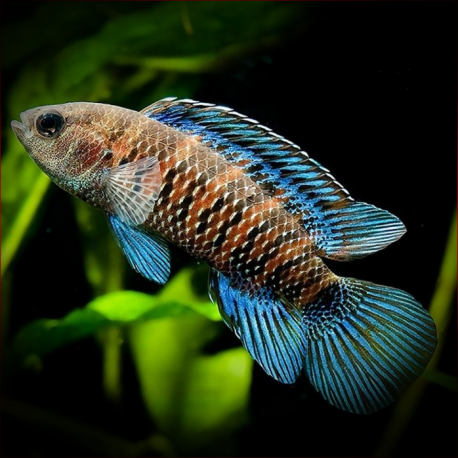More info
Datasheet
| Minimum Tank Size | 72 litres / 19.02 US gallons |
| Maximum Size | 6.0cm / 2.36inches |
| Temperature | 15°C / 59.00°F - 25°C / 77.00°F |
| Hardness | 3.03dgH / 54ppm - 15.02dgH / 268ppm |
| pH | 6.0-7.5 |
Behaviour:
The Badis species are known for their sluggish and retiring nature, making them easily intimidated or out-competed for food by larger or more aggressive fish species. It is recommended not to mix them with territorial benthic fishes unless the aquarium is exceptionally spacious. Additionally, caution should be exercised when housing them with other Badis species to avoid potential hybridization risks. Freshwater shrimp of the Caridina and Neocaridina genera may also be preyed upon by Badis fish. Male Badis can exhibit aggressive behavior towards rival males, particularly in confined spaces, hence it is advisable to keep only a single pair or one male with several females in smaller tanks. In more extensive aquariums, groups can coexist as long as each male has adequate space to establish its territory. Strategically placing caves in the tank can assist in minimizing aggression among males.
Feeding and Diet:
Badis species are micropredators that feed on small aquatic crustaceans, worms, insect larvae, and other zooplankton. In captivity, they often reject dried foods and should be fed small live or frozen options like Artemia, Daphnia, or glassworm. These fish are shy and deliberate feeders and can develop obesity-related health issues when fed chironomid larvae (bloodworm) and Tubifex, making it crucial to omit these items from their diet.
Reproduction & Dimorphism:
Members of the Badis genus are cave-spawners that form temporary pair bonds during breeding. Male Badis species become increasingly combative towards rival males as they enter breeding condition, displaying courting behaviors towards females. During breeding, males darken in color, their blue fins intensify, and they may lock mouths with the females while attempting to secure them in a cave for spawning. Typically, 30-100 eggs are laid during spawning. Post-spawning, the male takes sole responsibility for guarding the eggs and fry, defending the territory and caring for the brood. Females are smaller and less colorful than males, lacking blue pigmentation in their fins and having a rounder body shape. Mature males develop extended dorsal, anal, and caudal fins.
Habitat and Distribution:
Badis Badis are native to the Ganges River system, ranging from the Yamuna River in Himachal Pradesh, India, to the delta in Bangladesh, with additional sightings in Ganges tributaries in Nepal and various regions in India, such as Chhattisgarh, Orissa, Assam, and Guwahati. They prefer turbid waters with low flow and submerged vegetation, often found near water lily beds and may even coexist with B. assamensis in specific locations. The species thrives in shallow, slow-moving streams with mud substrates and moderate turbidity, supporting some aquatic plant growth.

